This post may contain affiliate links. Please see our disclosure policy.
Autumn olive jam is a delicious way to use autumn olives when they come in season in the fall. This wild foraged fruit is abundant, but it can be tricky to find autumn olive recipes anywhere.
Jam to the rescue!
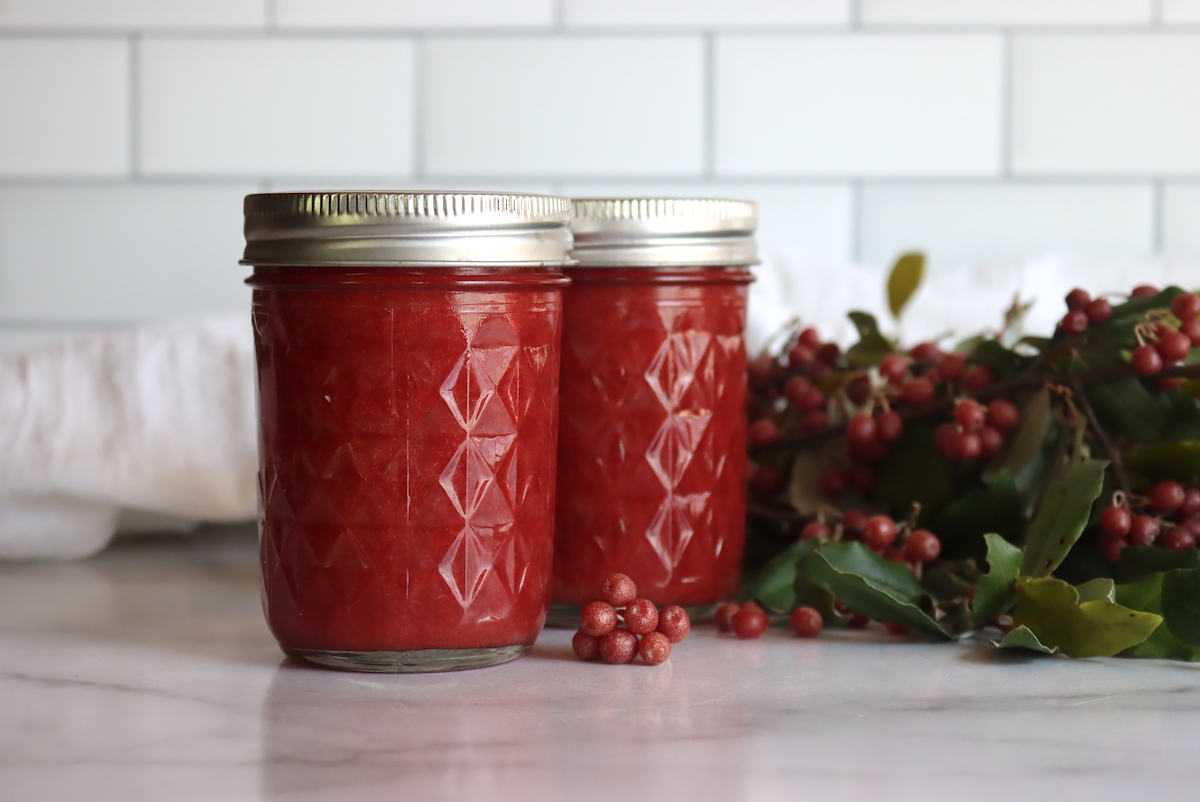
Autumn olives are one of those truly underappreciated wild fruits, and many people can’t stand the bushes. Those same people have likely never eaten the fruit, they’re just ripping them out because they have been labeled “invasive” by the powers that be.
In my book, if you have a hardy, nitrogen-fixing shrub that can grow just about anywhere, that also happens to produce delicious edible fruit…it’s a gift, not a curse.
Learning to identify wild autumn olive means you’ll have a ready supply of nutritious fruit late in the autumn, when most other summer fruits are long past.
And the best part? It makes a delicious autumn olive jam.
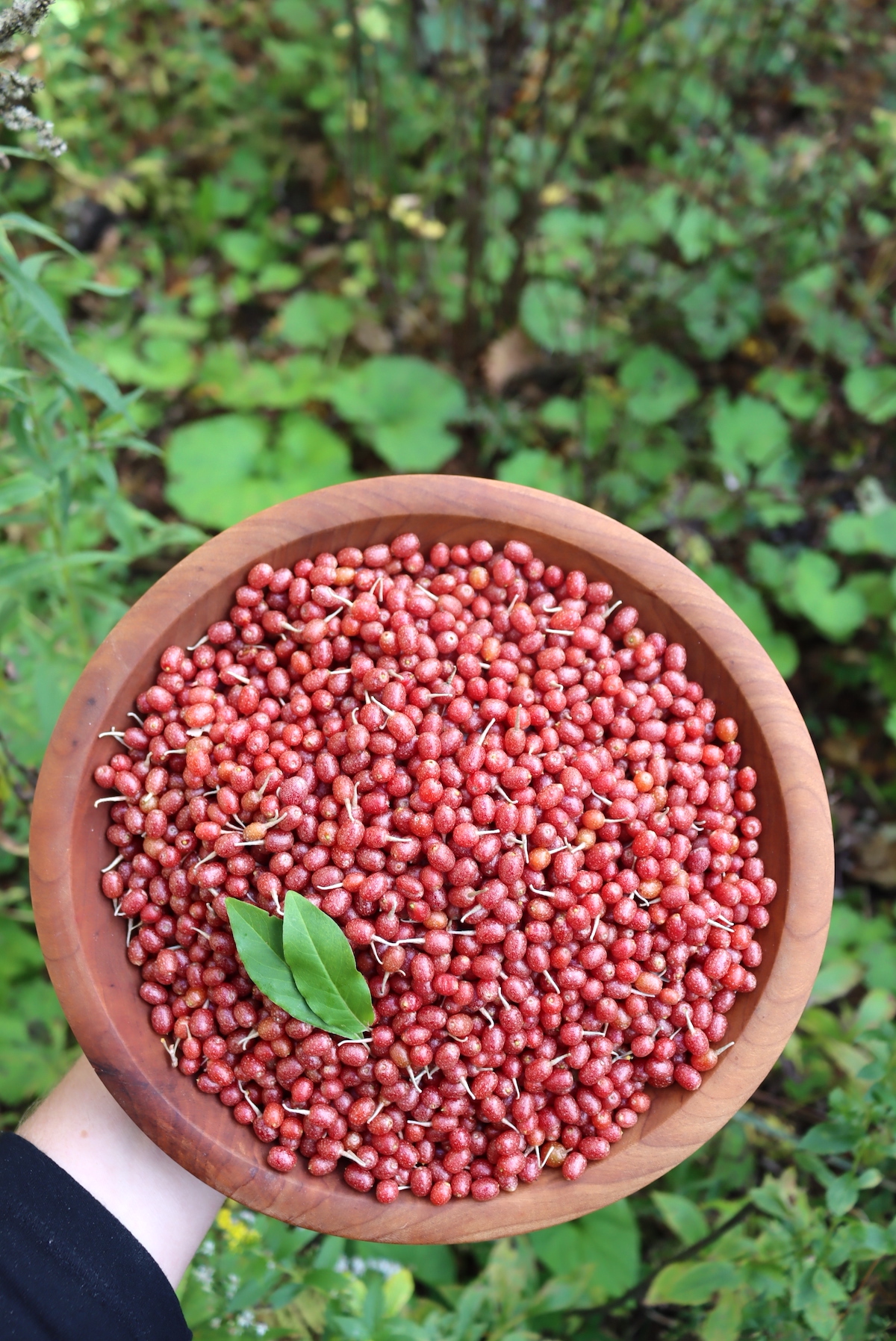
What are Autumn Olives?
Autumn olives (Elaeagnus umbellata) are a fast-growing, nitrogen-fixing shrub that’s native to Asian and the Himalayas. There are many other Elaeagnus species that look similar, and many of them are native to the US.
The other Elaeagnus species can also be used for jam, but the “non-native” Autumn olive just happens to be the best tasting. If you have other edible species, you can use them in place of autumn olive in this recipe.
Elaeagnus umbellata has silvery leaves and a distinctive small, oval-shaped speckled fruit with a single seed inside. The bush/trees grow between 6 and 12 feet tall, and can be quite prolific.
Be sure you have a positive ID before consuming them. Here’s where you can read about identifying autumn olive.
Autumn olives are best when harvested later in the season, after the first frost. The frost sweetens them up and removes some of their astringency.
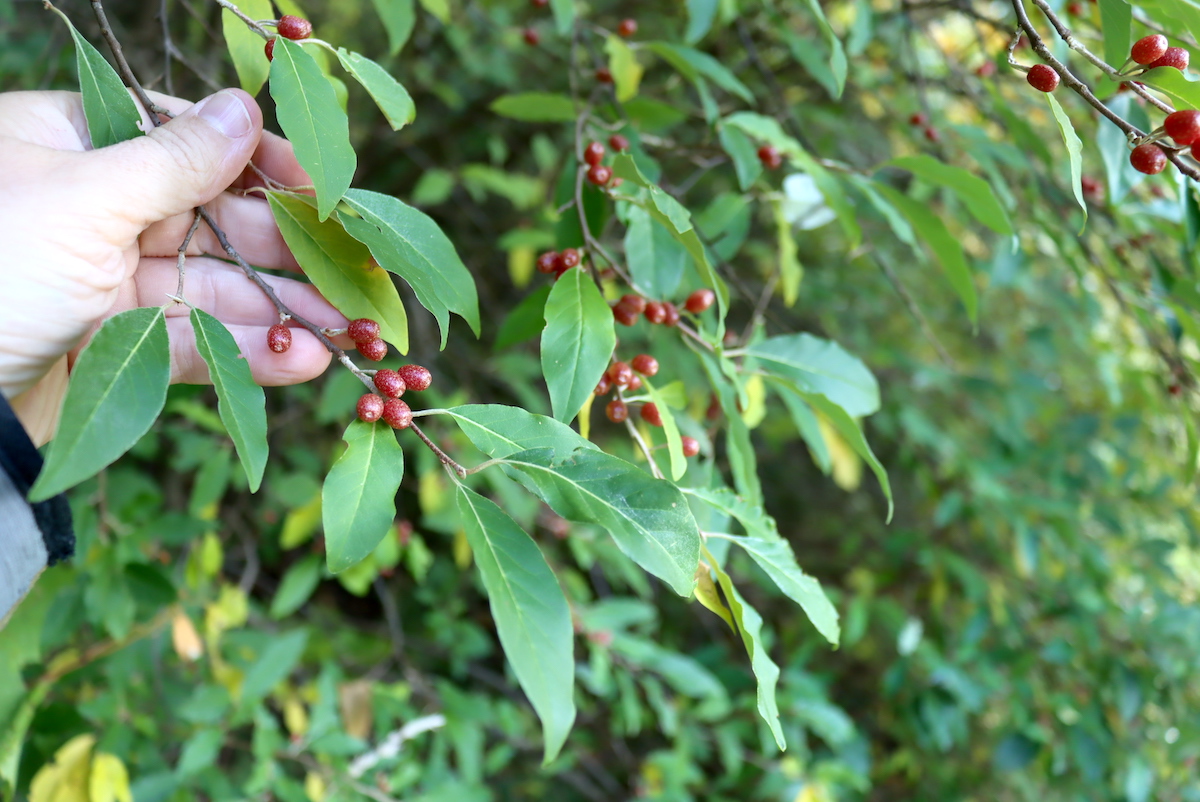
Are Autumn Olives Safe for Canning?
Since they’re a somewhat obscure wild fruit, there are no USDA recipes for canning autumn olives. They can’t cover everything, and there are literally thousands of species of fruit (wild and cultivated).
The USDA does, however, give us guidance that fruits need to be below a pH of 4.6 to be safe for canning. In tropical zones where jam is going to be stored in high heat (Hawaii, Puerto Rico, etc.) the safe canning line is a pH of 4.2.
(These don’t grow in tropical regions, they’re more of a cold, hardy crop, but still…4.2 is the most stringent pH requirement for safe canning.)
There are studies that test the pH of Autumn olives, and they’ve been conducted in different locations and growing conditions. All autumn olives tested ranged between a pH of 3.3 to 3.7, which is well below the line for safe canning (Source).

Ingredients for Autumn Olive Jam
To make autumn olive jam, all you need is fresh fruit, sugar, and a bit of pectin. You’ll also need just a bit of water to cook the fruit and extract the pulp from around the seeds.
The seeds are large in proportion to the size of the fruit, so you’ll need quite a bit of fruit to make a reasonable amount of jam.
One pound of autumn olive fruit is right about 3 1/2 cups by volume. When cooked with 1 cup water for a few minutes, and then processed through a fine mesh sieve, that yields about 2 cups of pulp.
It is really important to get the seeds out, as they’re quite large and too hard to leave in the jam. The skins and pulp still work through the mesh, so this is still a “jam” rather than autumn olive jelly.
If you want autumn olive jelly instead, use a jelly bag and just collect the liquid.
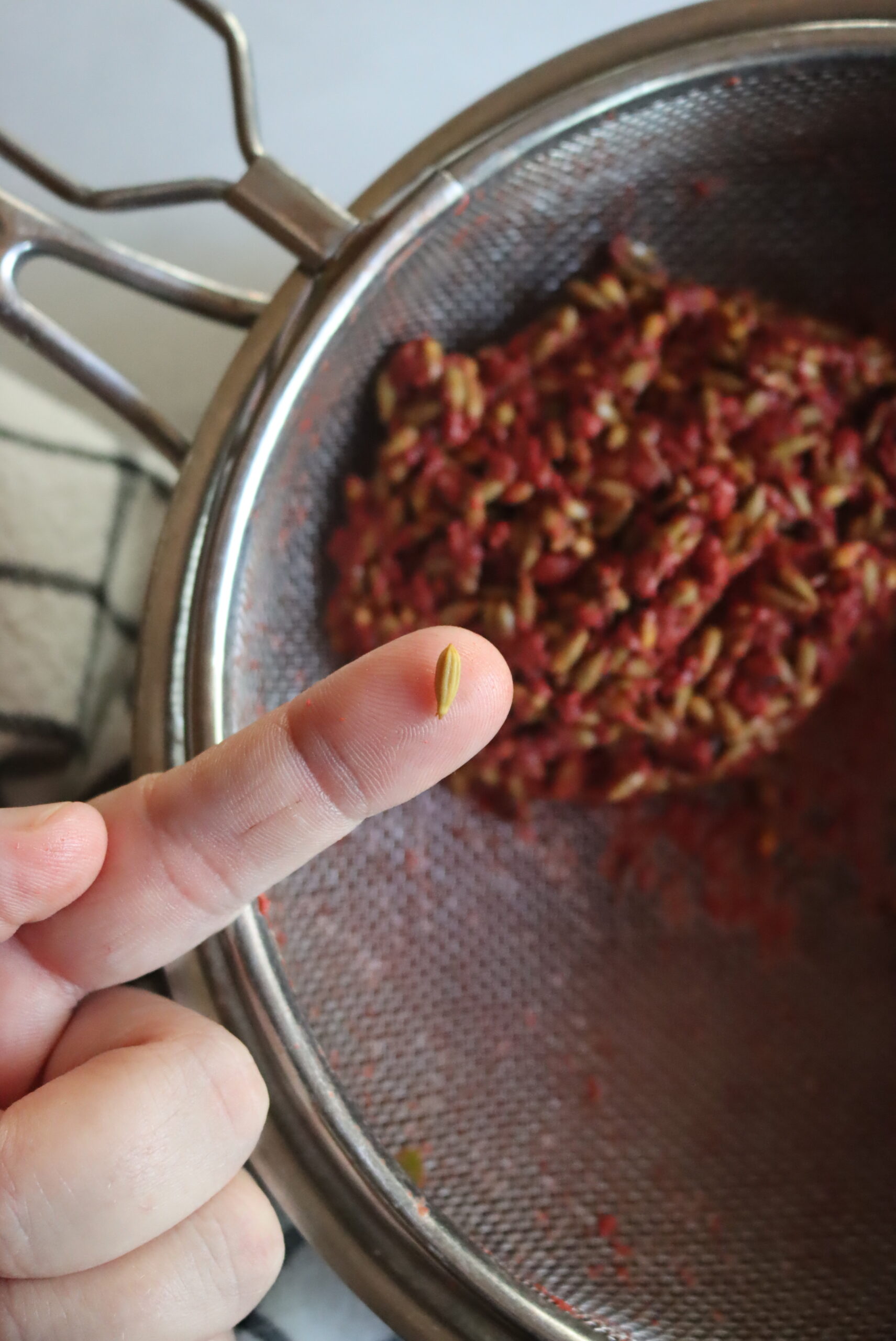
For a “batch” of jam using a single box of low-sugar pectin, you’ll need 6 cups pulp (from 3 lbs fruit). That should make 6 jam jars (8 oz each). The ingredients are as follows:
- 3 lbs autumn olive fruit, about 10 to 11 cups fresh fruit, to make 6 cups pulp
- 3 cups water, for cooking fruit
- 2 to 3 cups sugar
- 1 box (1.75 oz) low sugar pectin (such as sure jel)
How to Make Autumn Olive Jam
To make autumn olive jam, the first step is to cook the fruit with a bit of water to separate the pulp from the seeds. You need 1 cup water for every pound of fruit, so in a “batch” of jam you’ll need 3 cups water.
Place 3 lbs of fruit (10-11 cups) in 3 cups water, and bring to a boil on the stove. The fruit fall apart quickly, so stir for 1-2 minutes and then remove from the heat.
Press the fruit through a fine mesh sieve or food mill. That will separate the pulp from the seeds.
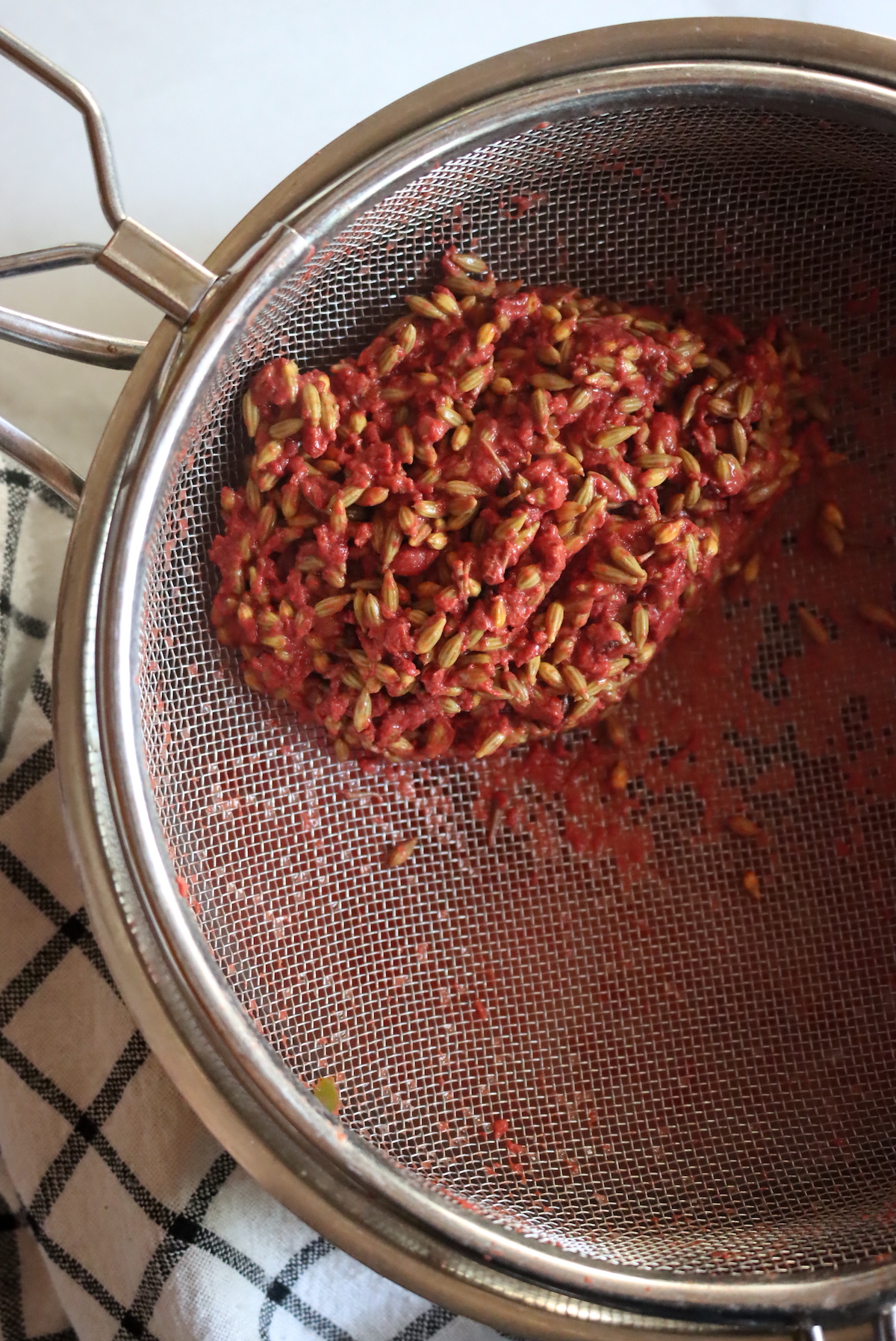
This season, I’m actually working on making a lot of wild foraged jams, and I processed a number of different fruit pulps on the same day.
Hawthorn pulp (for hawthorn ketchup) was the most difficult, while barberry, Aronia, and autumn olive were quite simple.
I’ll definitely make autumn olive jam again, and barberry jam, as both are spectacular. Aronia jam is good, but a bit astringent. Hawthorns are just too hard to pulp, and I’m sticking with hawthorn jelly in the future.
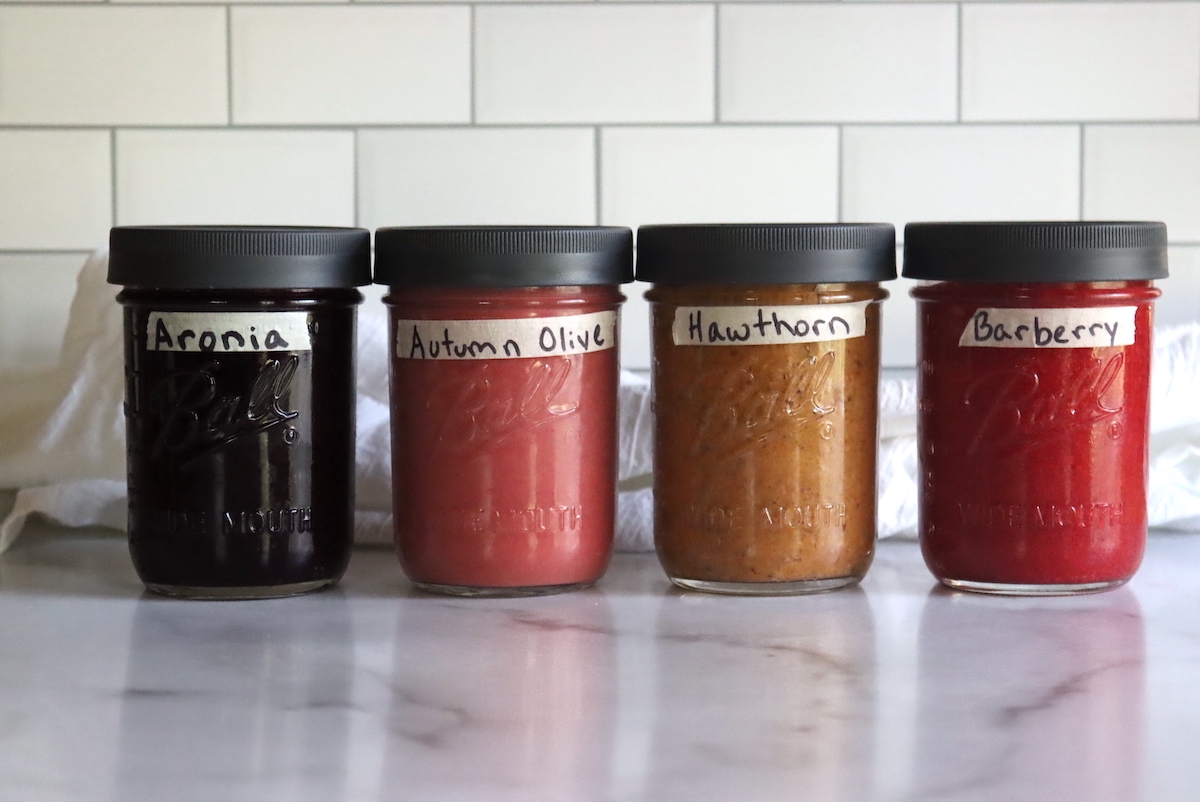
A pound of fruit cooked with 1 cup of water should yield about a pint of autumn olive pulp. This recipe uses 3 lbs, so you should have about 6 cups fruit pulp.
Place that fruit pulp back in a jam pot, and bring it to a boil. (Don’t add the sugar yet.)
Add in a box of low-sugar pectin(such as sure jel low sugar). Stir to incorporate and bring the mixture back to a boil for 1 minute.
Add in the sugar, somewhere between 2 and 4 cups, depending on your tastes.
Two cups is my preference, and it yields a sweet-tart jam. A “full sugar” jam would be more like 4 cups and will come out very sweet. Either way, you’re using pectin which will set regardless of the amount of sugar used.
(Don’t use “regular” full sugar pectin, which requires a 1:1 ratio of sugar to fruit, and autumn olives are already quite sweet. That’d be 6 cups of sugar, and that’s crazy sweet. Similarly, liquid pecin would require even more, at 7 to 8 cups sugar. I don’t recommend those for autumn olive jam.)
Once the sugar is added, bring the mixture back to a boil for 1 minute and then remove from the heat.
Ladle into prepared jars, leaving 1/4 inch headspace.
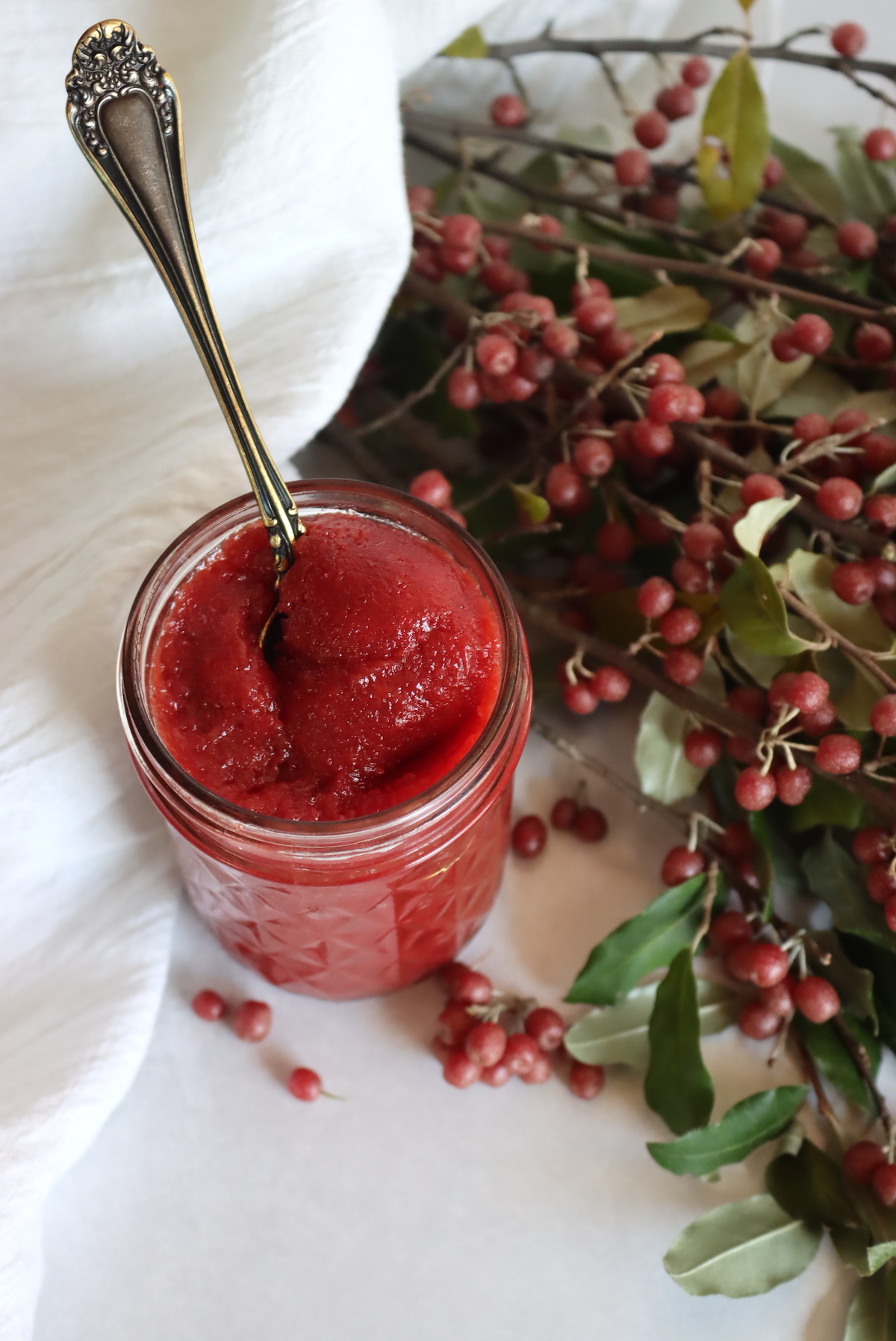
Canning Autumn Olive Jam
It’s perfectly fine to make this autumn olive jam recipe as a refrigerator jam (or a freezer jam). It’ll last several weeks in the refrigerator and up to 6 months in the freezer.
If freezing, be sure to leave plenty of headspace and use freezer-safe jars.
I prefer to can my jams because then they’ll keep for 18+ months right on the pantry shelf. You’ve gone through the trouble of foraging autumn olives; it’d be nice if you could enjoy them at your leisure instead of having to rush to eat them before it spoils in the refrigerator.
The fruit have a pH between 3.3 and 3.7, which means they’re acidic enough for home canning.
If canning, prepare a water bath canner before you begin cooking the jam.
Once the jam is ready, ladle it into prepared canning jars, leaving 1/4 inch headspace. Cap with 2-part canning lids and process in a water bath canner for 10 minutes (15 minutes if above 6,000 feet in elevation).
Remove the jars to cool on a towel on the counter, and check the seals after 12-24 hours when the jars have cooled completely. Store any unsealed jars in the refrigerator for immediate use.
Properly canned and sealed jars of Autumn Olive jam will maintain peak quality on the pantry shelf for around 18 months. Past that, they’re still good, provided they’re sealed, but the quality will start to decline.
Refrigerate after opening.
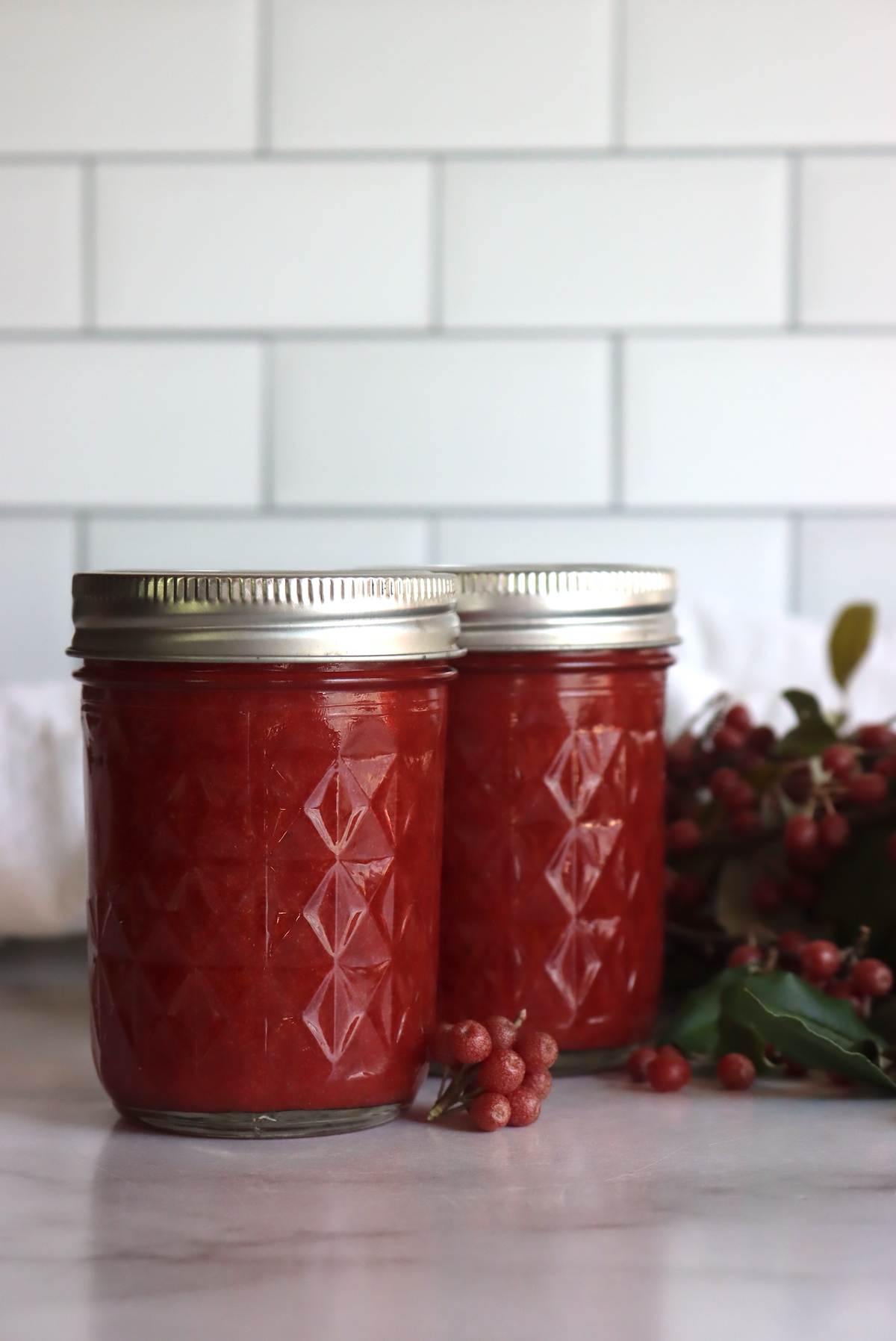
Autumn Olive Recipes
Looking for more Autumn Olive Recipes?
- Autumn Olive Ketchup ~ Learning and Yearning
- Autumn Olive Cookies ~ Edible Wild Food
- Autumn Olive Jelly ~ Unruly Gardening
- Autumn Olive White Chocolate Chip Cookies ~ Doughn’t Worry, Bake Happy
- Lemon and Autumn Olive Tart ~ Edible Wild Food
- Autumn Olive Cinnamon Swirl Loaf Bread ~ Doughn’t Worry, Bake Happy
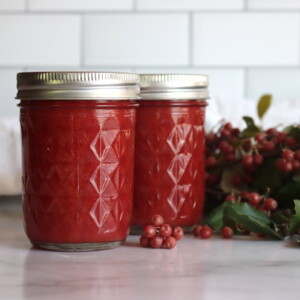
Autumn Olive Jam
Ingredients
- 3 lbs autumn olive fruit, about 10 to 11 cups fresh fruit, to make 6 cups pulp
- 3 cups water, for cooking fruit
- 1 to 4 cups sugar, see note
- 1 box, 1.75 oz low sugar pectin (such as sure jel low sugar)
Instructions
- Place the autumn olives in a pot with a bit of water. Use 1 cup of water per pound of autumn olives, or for the full recipe, 3 cups water and 3 lbs autumn olives (10-11 cups fruit).
- Bring to a boil and then cook the fruit with water for 1 to 2 minutes, until it falls apart.
- Strain the fruit through a fine mesh strainer, working the fruit with a spatula to push the pulp through but keep the seeds in the strainer. You should have about 6 cups pulp.
- Place the strained fruit back into a jam pot, bring it to a boil, and add the powdered pectin. (Don't add the sugar yet.) Boil the fruit pulp and pectin for 1 minute, stirring to incorporate.
- Add the sugar, stir to incorporate, and return to a boil for 1 minute. Remove from heat and ladle into prepared jars, leaving 1/4 inch headspace.
- If canning, process in a water bath canner for 10 minutes (15 minutes above 6,000 feet in elevation).
- Cool jars completely on a towel on the counter, and check seals. Store any unsealed jars in the refrigerator for immediate use. Sealed jars will keep on the pantry shelf. Refrigerate after opening.
Notes
Sugar
For a "low sugar" sweet/tart jam, go with 1 to 2 cups sugar. I used 2 cups sugar, and it was just right for my low-sugar tastes. Tart, but not too tart. A "full sugar" jam would be more like 4 cups and will come out very sweet. Either way, you're using pectin which will set regardless of the amount of sugar used. (Don't use "regular" full sugar pectin, which requires a 1:1 ratio of sugar to fruit, and autumn olives are already quite sweet. That'd be 6 cups of sugar, and that's crazy sweet. Similarly, liquid pecin would require even more, at 7 to 8 cups sugar. I don't recommend those for autumn olive jam.) Autumn olives are already quite sweet, so keep that in mind.Shelf Life
It's perfectly fine to make this autumn olive jam recipe as a refrigerator jam (or a freezer jam). It'll last several weeks in the refrigerator and up to 6 months in the freezer. If freezing, be sure to leave plenty of headspace and use freezer-safe jars. Properly canned and sealed jars of autumn olive jam will maintain peak quality on the pantry shelf for around 18 months. Past that, they're still good, provided they're sealed, but the quality will start to decline. Refrigerate after opening.Wild Foraged Preserves
Looking for more ways to preserve wild food?
Autumn Canning Recipes
Putting up more than wild fruit this season?
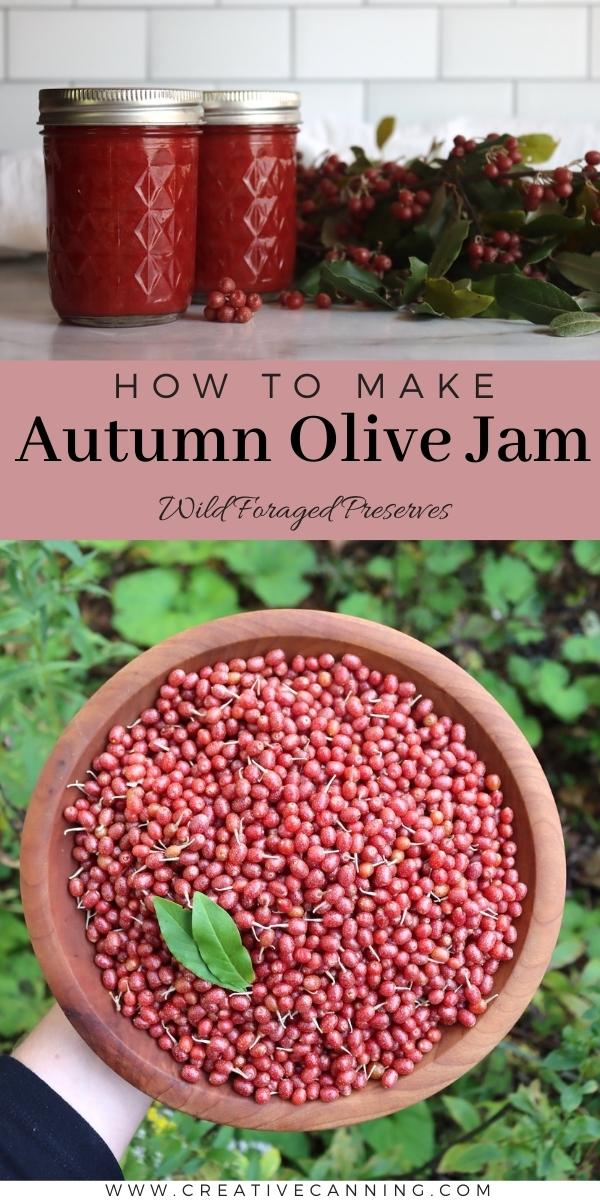
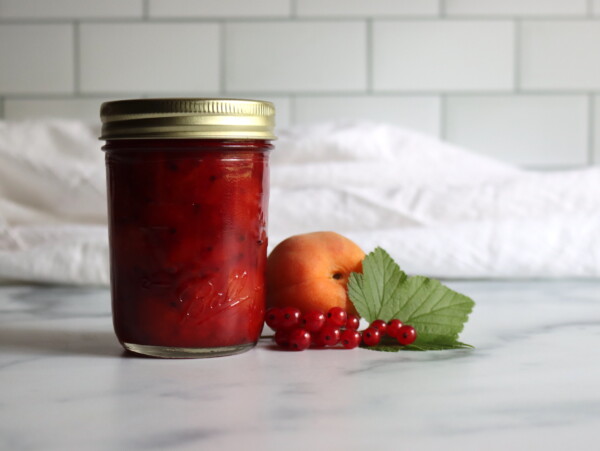
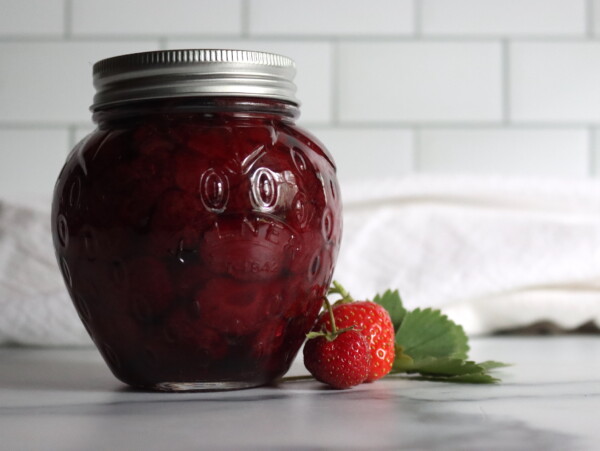
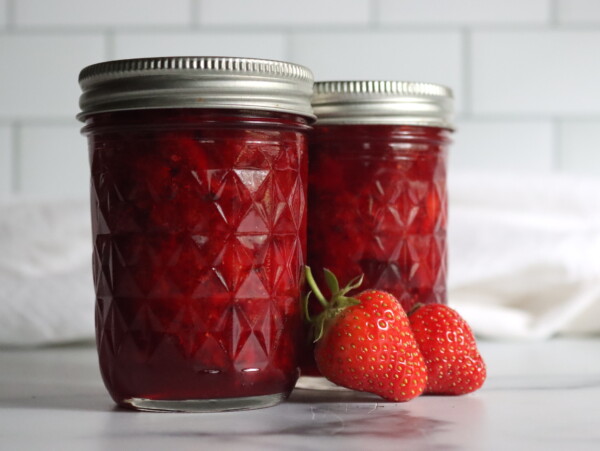
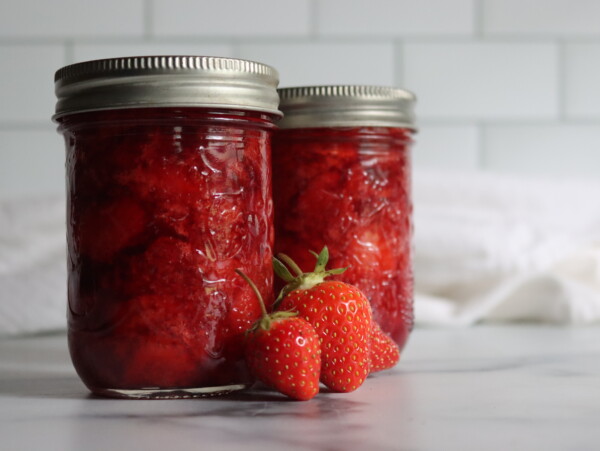
I love this recipe
Easy and delicious
Very light tasting jam.
My family calls it a delicacy
I am making my second batch now.
So glad you enjoyed it!
I learned that using pectin that expired two years ago won’t set, even if it was still sealed 😀
The flavor of my pancake syrup is delicious, and perfectly sweet/tart with two cups of sugar used.
My unintended syrup separated into a white layer on top, about a quarter inch wide, and red on the bottom. Does anyone know what this might be, and if it’s common?
Autumn olive juice separates into a clear layer with red on the bottom when not set. It might be white due to the unset pectin? That’s a guess, but I have no idea.
I just made this but with goumi berries a relative of the autumn olive. Turned out amazing and I have no jam making skills. I never have a use for them but now I do! Thanks for the recipe without tons of sugar.
Nice! I’ve never worked with fresh goumi berries, and I don’t know if they’re acidic enough for canning. They need to have a pH in their juice under 4.6, but I can’t find any sources one way or the other. They might be better as a refrigerator preserve given the uncertainty there.